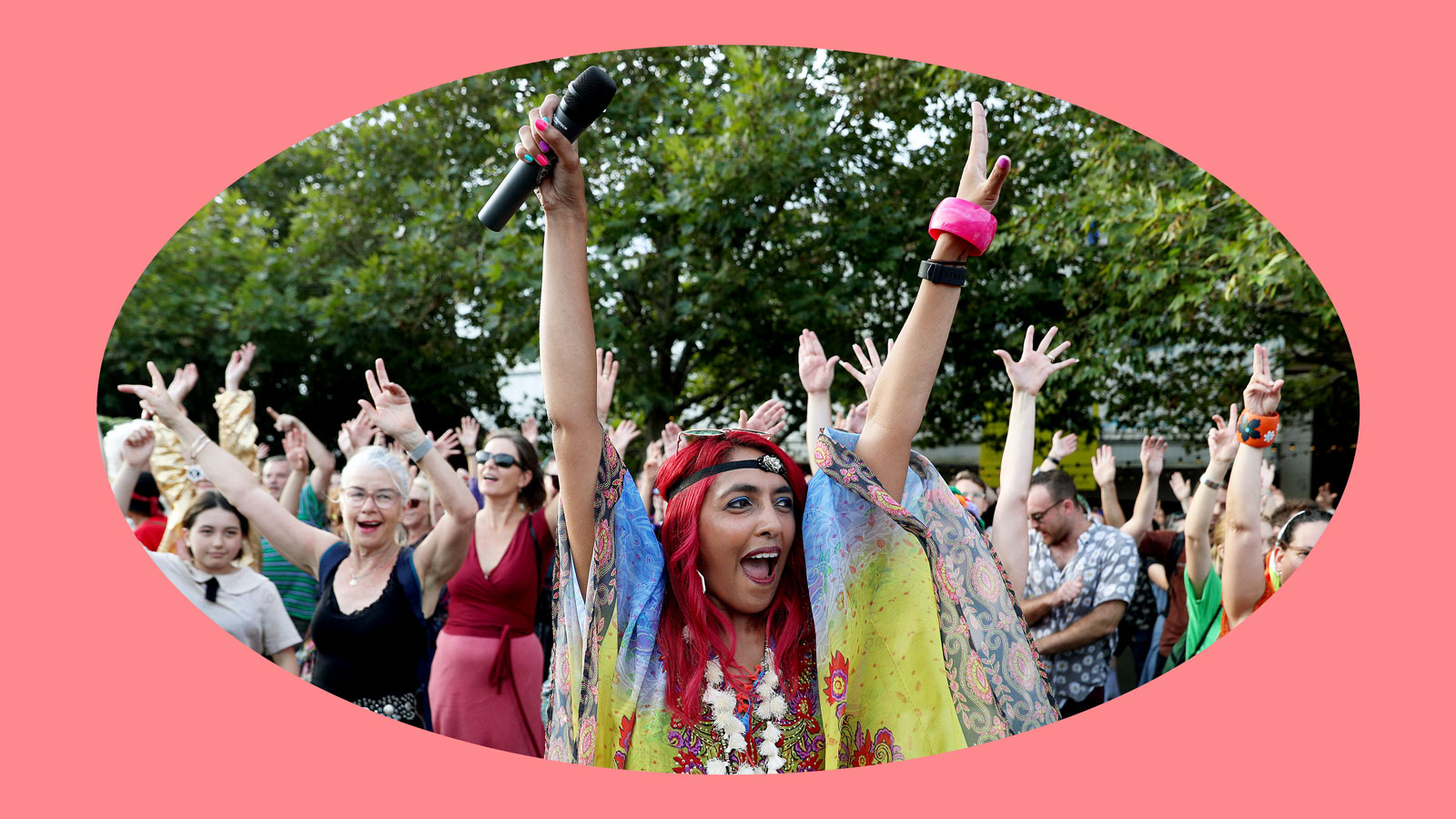Joy can strengthen our resolve, help us unlock creativity, and bolster our resilience. In Fix’s Joy Issue, we explore the importance and power of finding joy in the face of grief, anger, and a changing climate.
Rachael Baker dropped out of college in 2020 and became a full-time climate organizer. Not long after, George Floyd was killed by the police in Minneapolis and Black Lives Matter uprisings swept the country and the world. “Oh, my god,” Baker says. “I swear that whole summer, my neck just hurt and my body felt empty.”
As a Black woman, Baker thought a lot about her ancestors who endured violence for generations and often turned to the joy of community — making good food, sharing stories, telling jokes — to survive it. “In that laughter,” she says, “you have enough good energy, enough love in you, to keep going and not just fall down.”
For climate organizers, too, joy “is part of our survival kit. It’s how we combat despair,” says Baker. “And we know when we [feel] despair, then they win.”
The point isn’t to avoid grief, which is a natural and healthy response to the state of the world, but rather to avoid drowning in it. Baker and others like her are part of an effort within the climate-activist movement to make joy a key part of its organizing toolkit.
Joy-as-resistance is a technique that goes back thousands of years. Beyond providing catharsis and strengthening group bonds, activists see it as necessary to advance their ultimate goal — a just, livable future — by keeping advocates engaged and attracting more people to the movement.
Protest art, celebratory demonstrations, and music in the streets also help draw in the public, grab media attention, and startle and disrupt the powers that be. Rachel Schragis, cofounder of Look Loud and an arts organizer for the 2014 People’s Climate March in New York City that drew an estimated 311,000 people, says, “I believe in joy because it’s a technology that I’ve seen work over and over.”
* * *
In June 2021, activists captured the public’s attention when they marched 400 miles from New Orleans to Houston to pressure legislators to support the creation of a Civilian Climate Corps. “We had a band play, and we were dancing and singing,” says Baker, who participated in the march. “There were people who joined us, [who] saw what we were doing and asked questions. I feel like when you are enjoying the work, and you enjoy the people that you’re doing it with — that’s contagious.”
Getting through our current crisis requires creative ways of attracting people who might otherwise become apathetic, or worse. “To think about our future and to think about the next few years — it can make you fall down, it can make you faint,” says Baker. Climate activism provided something to do about it. During her first encounter with Sunrise Movement, about 50 young people started a meeting in song. The rest was history, she says: “Organizing stuck.”
Audrey Lin, campaign manager for Sunrise Movement, felt the same way during her early experiences with the organization. “When we sang a song to close out that space, I was like, ‘Oh, yeah, this is the group of people that I know that I want to not only be in community with, but also to be with me in this fight and to be by my side as we organize.’”
In that way, joy is a recruiting strategy, and there’s little wonder why. “When you get a good chant going and someone is banging on the drums,” Baker says, “all of a sudden you’re dancing in the middle of the street with 10,000 other people. And I don’t know if there’s anything more powerful than that.”
[Read more: Lin and Baker share how finding space for joy keeps them going]
Social moments throughout history “have used music as a way of inviting and maintaining broad-based participation in their initiatives,” politics professor Tracey Nicholls wrote in a 2015 research paper, citing Black nationalism, the U.S. labor movement, and resistances against authoritarian regimes.

Monica Hunken, a direct action trainer who has brought theatrics and visual art to organizations like Greenpeace and Rainforest Action Network, draws inspiration from the Otpor, a civic protest group and movement that adopted creative tactics to resist fascism in Serbia during the reign of Slobodan Milošević in the 1990s. One strategy involved putting photos of Milošević on dogs and letting them run around, which made people laugh and provided a means of “undercutting that power,” she says. The group ultimately used humor to help people see a way forward.
“Inviting people into sorrow is a very hard ask,” says Hunken. But imagination, she says, is “a boundless source of energy and inspiration. There’s no end to that because it just keeps giving.”
* * *
Using cultural traditions of joy to get through hard times dates back millennia. Schragis describes this as the “ancestral wisdom of catharsis and joy” and cites Purim, a Jewish holiday that comes from her own tradition, as one of many examples. It is a festival based on a story of resisting tyrants, but it is also a spectacular celebration of liberation, known for its costumes, storytelling, dancing, and mirth.
The civil rights movement relied on spirituality, protest music, and an unwavering optimism to endure often violent pushback. Some of the music of the time was somber, but often it was joyful — just check out this uplifting version of “This Little Light of Mine” that the Freedom Singers performed in the mid-1960s. Twenty-five years ago, ACT UP embraced joy in the face of staggering loss when it staged a nationwide “kiss-in” to bring attention to the AIDS crisis. It was a joyful expression of love during a time when gay people and other impacted communities faced rampant stigma and discrimination.
Jayeesha Dutta, a board member of the Climate Justice Alliance and an activist for three decades, recognizes the need for joy in order to keep on going. She already felt burned-out when she came to the climate movement in 2013 to work for the Gulf Future Coalition and didn’t think she would last long. “I was about to quit my job. I was like, ‘This is too much. I didn’t sign up for this.’” But she attended the opening of “Cry You One,” a site-adaptive outdoor and virtual performance that used music, dance, and the traditions of Southeast Louisiana to share stories of environmental racism and coastal land loss. The performance, which she described as “joyful and grief-ful,” changed everything. “By far, for me, it was the motivating factor of staying,” she says, “because it brought me that inspiration and joy.”
Joy “is part of our survival kit. It’s how we combat despair.”
— Climate activist Rachael Baker
As a seasoned activist, Dutta has seen the stressed-out, angry organizing culture fail at times. In the late ’90s, she attended a multi-week conference in Washington, D.C., hosted by a large union with a goal of reigniting the labor movement. “The initiative’s objective was to motivate us to become labor organizers, and it actually did the opposite for me. I was like, ‘Oh, this seems like people are way too serious [and] always stressed out. That’s not what I want to set myself up for, for my whole life.’”
Dutta has since become program director at the Windcall Institute, which bills itself as an organization that supports the “staying power” of activists “for the long haul,” by creating in-person and remote spaces for “rejuvenation and mental, emotional, physical and spiritual balance.” Her many years in organizing have taught her that prioritizing the well-being of people doing this hard work is crucial to the success of social movements. “I really see my work at Windcall as being climate work,” says Dutta.
* * *
On June 28 2021, approximately 70 activists were blockading the entrance to the White House, calling on President Biden to deliver a fully funded Civilian Climate Corps, when it started to pour. They were soon soaked and cold. But even though their voices were hoarse from singing for hours, they decided to keep going. For Sunrise Movement’s Lin, who helped plan the action, being with others who energized her and brought her joy was what made that possible. “I think that it was the collective joy of being with each other that kept us there even in sort of a hard moment,” she says, adding that joy stands “in direct opposition to the people who want us to just give up and go home.”
Schragis agrees. “When we feel connected to each other and safe, we’re able to take risks. And we have to take risks in order to win justice for everyone,” she says.
Joy also catches people off guard. Employees at the JPMorgan Chase Bank headquarters in Midtown Manhattan were surprised, perhaps even captivated, when a partially clothed flash mob of 30 singers and dancers entered the lobby on September 23, 2019, to protest the institution’s funding of fracked gas pipelines, particularly the Williams Pipeline that would pass through New York Harbor. That demonstration, organized by Hunken with the Rainforest Action Network, included dancing, singing, and someone dressed as Chase CEO Jamie Dimon covered in “oil.” In the spring of 2020, New York State’s Department of Environmental Conservation made a ruling to deny the application for the pipeline project.

“It’s so powerful to go into a space like that and to bring this emergence of life and of ridiculousness,” says Hunken.
As someone who has been arrested during protests, Hunken knows that standing up to authority can be intimidating, even dangerous. That’s why she finds it important to poke holes in that power by creating joyous disruptions. “If people are feeling only that fear, it cuts you off from breathing and from feeling and from action,” she says. “And to start to be able to laugh, then you’re getting in your body and you’re seeing, ‘Oh, this is something I could take down.’”
A stimulating, mirthful action is a tactical move. The police have protocols for how to respond to disruptions, but it’s not as simple when they are confronted with things like theater. Because there’s no script, Hunken says, “there’s so much unknown.”
“I’ve done a lot of actions and a lot of blockades,” she says, “and we always have more time in the space … with theater or dance or music,” before the police break up the scene. Sometimes, she says “the security guards might even enjoy it.”
* * *
In a movement made up of people from diverse backgrounds, the question of how to bring joy into protest can be a complicated one. Just like the broader world, its internal spaces contain racism, classism, sexism, and other forms of oppression. Given that, Schragis, who is white and has worked in multiracial justice movements for a decade, has been wrestling with the question of how people can have a collective, simultaneously emotional experience that feels authentic. She is not alone. Many are grappling with how to be sensitive to and inclusive of different cultural experiences of joy, and also acknowledge its limits in addressing wounds that date back generations.
But joy can be useful in helping us “humanize each other … where we can actually see each other as full beings,” Lin, who identifies as mixed race, says — with the caveat that joy needs to be thoughtful. She is excited about a forthcoming climate songbook from Sunrise that represents a variety of movements and cultures and includes a description of each song’s history. “Whenever possible, and whenever we are sharing songs from other movements, it’s really important to ground in that history,” she says. Baker shares this sentiment, and says that sometimes she doesn’t feel comfortable singing a song like “Woke Up this Mornin’” alongside white activists, because “that song is deeply connected to being out in the fields or to fighting against segregation.”
Sunrise Movement has also created a Black caucus as a separate space within the organization. “[Black people’s] voices, our lived experience, our wisdom needs to be at the forefront, alongside Indigenous and Latine and working-class people,” says Baker, “and in order for us to do that, there’s a lot of healing that needs to be done, especially in a predominantly white organization.” The Black Caucus is an opportunity for “reveling in our Black joy” together, says Baker, and to do the necessary work of talking through instances of racism and healing.
* * *
In the current political and ecological climate, it has often felt harder than ever to summon joy, and it sometimes can feel out of place.
“The hunger strike was a different experience, where instead of holding these loud and kind of raucous and exciting rallies, we were holding things like vigils,” says Lin, referring to the 2021 action meant to pressure Congress to climate action after West Virginia Democratic Senator Joe Manchin refused to support the White House’s plan on climate emissions.
But, Lin says, finding space for joy within climate organizing doesn’t minimize the anger and frustration people are experiencing. If anything, as the anger and frustration increase, joy has to increase alongside it. “I think there is room for both,” says Lin. As activist Malkia Devich-Cyril wrote for In These Times, “Joy is not the opposite of grief. Grief is the opposite of indifference.”
“Part of our climate movement can be relying on the immense beauty of nature, and the immense beauty of all these things that we are at risk of losing if we don’t do something right,” says Dutta. But that doesn’t mean denying the urgency of everything we want to change. “The joy doesn’t have to be absent from the truth.”
Explore more from Fix’s Joy Issue:
- When children imagine the future, a world of climate possibilities emerges
- Hila the Killa dresses up as the Earth and raps about climate. Audiences love it.
- 13 ideas for building a climate-friendly lifestyle you can stick with





